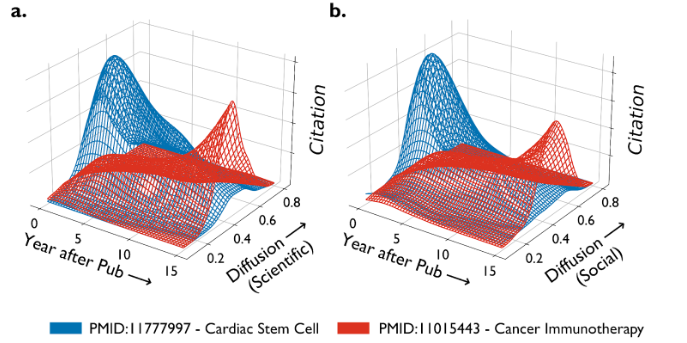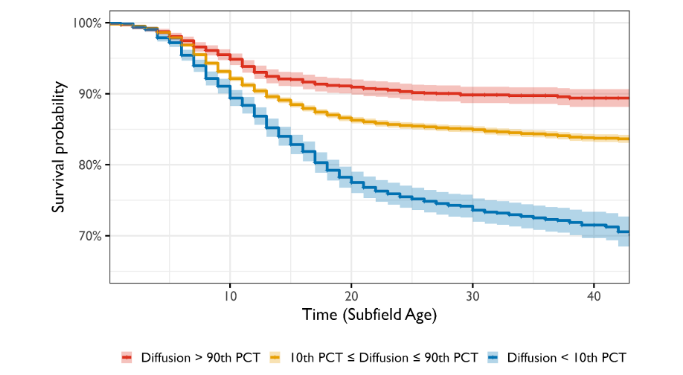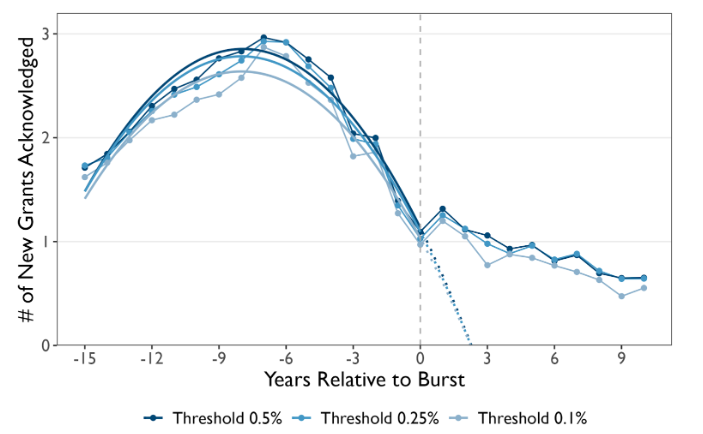Limited Diffusion of Scientific Knowledge Forecasts Collapse
Published in Social Sciences and Biomedical Research

The growth and decline of scientific ideas have been critical to modern medicine; however, little consideration has been paid to how this occurs through the diffusion of biomedical knowledge and the trust placed in ideas by researchers and clinicians. Inspired by the analogy of stock market bubbles, we posit that abrupt declines in the popularity of research ideas resemble the bursting of epistemic ‘bubbles.’ We hypothesized that these bubbles could be identified by tracing how broadly ideas diffuse across social and scientific space. Our goal was to provide a diagnostic framework to identify robust ideas to build upon for further inquiry, which can contribute to a healthier information ecosystem for science. In the context of the biomedical sciences where we focus, we also sought to improve healthcare outcomes and better resource allocation in biomedical research.
Our work harnessed large-scale biomedical datasets, including the PubMed Knowledge Graph1, MEDLINE, the National Institutes of Health (NIH) iCite database, and subfield-level data2. We applied a neural embedding model3 to represent biomedical publications in two dimensions: scientific space trained on Medical Subject Heading (MeSH) keywords and social space embedding co-authorship patterns. By encoding the proximity of keywords or researchers beyond direct co-occurrence or collaboration, our models allowed us to measure knowledge diffusion across scientific and social distances and paint a richer picture of the dynamics underlying scientific influence and knowledge diffusion.
We first applied our framework to two prominent papers, each drawn from Cardiac Stem Cell and Cancer Immunotherapy research, as shown in Fig. 1. The left panel (Fig. 1a) focuses on cardiac regeneration research led by Dr. Piero Anversa. The paper initially drew significant attention for suggesting that bone marrow-derived cells could regenerate heart tissue. These findings could not be replicated, however, leading to a sharp decline in the field’s popularity—a clear example of an epistemic bubble bursting. By contrast, Fig. 1b shows a seminal cancer immunotherapy paper, which started with slower attention but eventually diffused more widely, leading to a Nobel Prize-winning breakthrough in 2018. Drs. Tasuku Honjo and James P. Allison’s work on inhibiting immune regulation to treat cancer became a major innovation in cancer research. These contrasting examples illustrate how our approach, which accounts for epistemic bubbles, provides deeper insights into how the diffusion of scientific ideas across social and scientific collaboration networks may matter.

Fig. 1: Representation of different diffusion levels and contrasting diffusion trajectories. Panels a and b illustrate 3D kernel density plots of diffusion indices and citations for PMID 11777997 (Cardiac Stem Cell) and PMID 11015443 (Cancer Immunotherapy) in scientific and social spaces, respectively. Publication years associated with each article are aligned to zero for comparison. Annual diffusion indices and citation counts are computed using a two-year rolling average.
Building on these examples, we extended the approach beyond the single scientist or scientific team by elevating our analysis to the level of scientific subfields. We applied our framework to 28,504 unique biomedical subfields2. We hypothesized that if work within a subfield is predominantly cited by research in close social and scientific proximity, the subfield’s insights may not diffuse despite its apparent popularity. This constricted diffusion could indicate inflated value, increasing the risk of a dramatic decline in attention or “bubble bursting.” If true, this dynamic in science would be analogous to the phenomenon on the internet and social media of pumping up information popularity by individuals or small groups such that it tricks the recommendation algorithm (e.g., Google’s Pagerank, Meta’s Newsfeed, TikTok recommended videos) into temporarily promoting their ideas as if they reflected widespread emergence.
To quantify this, we extended our framework to a subfield level by measuring the average angular distances between cited and citing papers, separately within scientific and social spaces. Using a nonparametric survival model, Fig. 2 illustrates that limited diffusion strongly correlates with the likelihood of a bubble bursting. We further confirmed this pattern using discrete-time event history models that account for temporal covariates: the lower the diffusion, the higher the likelihood that the subfield will experience an abrupt collapse in attention.
 Fig. 2: Survival probability against bubble bursting as a function of knowledge diffusion in social space. Events are defined as a sharp decline in 2-year citation counts at the subfield level with a 0.5% cutoff (see Method). Survival refers to the converse, i.e., not experiencing a subfield-level extreme deflationary event. Subfield ages are set to 0 in the year when the focal seed article spanning the subfield was published. Diffusion percentiles are ranked within calendar years and subfield ages. The crosses denote the estimated mean survival probabilities at a given subfield age, and the bands depict 95% confidence intervals.
Fig. 2: Survival probability against bubble bursting as a function of knowledge diffusion in social space. Events are defined as a sharp decline in 2-year citation counts at the subfield level with a 0.5% cutoff (see Method). Survival refers to the converse, i.e., not experiencing a subfield-level extreme deflationary event. Subfield ages are set to 0 in the year when the focal seed article spanning the subfield was published. Diffusion percentiles are ranked within calendar years and subfield ages. The crosses denote the estimated mean survival probabilities at a given subfield age, and the bands depict 95% confidence intervals.
We also explored the characteristics of socio-epistemic bubbles and the consequences of their collapse. Our analysis found a positive correlation between the concentration of publications from elite scientists within a subfield and the likelihood of an attentional collapse. Similarly, we observed that the proportion of NIH funding allocated to collaborators of prominent scientists was positively associated with the likelihood of collapse, as demonstrated by the case of Cardiac Stem Cell research. These findings suggest that the concentration of “scientific capital,”4 in terms of reputation and resources, may contribute to the formation of epistemic bubbles in science, as exemplified by the Stem Cell Cardiac case. We also found that subfields with higher clinical translatability are less likely to experience these bubbles and collapses.
We also found that more than 80% of subfields that experienced a bubble bursting continued to receive new grants long after their collapse. As shown in Fig. 3, while peaks in new funding occur roughly seven years before a collapse, the rate of funding declines more slowly after the bubble bursts. Our extrapolation suggests that funding would completely taper off three years after the bubble burst. This lag suggests how substantial financial resources continue to be allocated to areas of research that have lost broader relevance.
 Fig. 3: The average number of new grants acknowledged in collapsed subfields by years relative to burst. The quadratic fit is applied to data from years -15 to 0 relative to the burst year, with dotted lines representing extrapolations starting from year 0 onwards.
Fig. 3: The average number of new grants acknowledged in collapsed subfields by years relative to burst. The quadratic fit is applied to data from years -15 to 0 relative to the burst year, with dotted lines representing extrapolations starting from year 0 onwards.
Our work highlights that limited diffusion, captured by limited distances between focal and citing papers measured across scientific and social space, signal epistemic bubbles5. Funding agencies can leverage our framework to proactively identify and mitigate potential scientific bubbles, which can facilitate the reallocation of resources to diverse researchers in order to probe suspect fields for robustness. This approach may also be adapted to other crucial domains, such as tackling misinformation by measuring its diffusion. A natural extension of this work would be to apply it beyond biomedical science to investigate whether the absence of bubbles signals more meaningful, novel, and generalizable contributions to science, technology, and society.
*The figures illustrating the post are adapted from the original paper.
References
1. Taylor, M. & Heath, B. Years after Brigham-Harvard scandal, U.S. pours millions into tainted stem-cell field. Reuters (2022).
2. Azoulay, P., Fons-Rosen, C. & Zivin, J. S. G. Does Science Advance One Funeral at a Time? Am. Econ. Rev. 109, 2889–2920 (2019).
3. Le, Q. & Mikolov, T. Distributed Representations of Sentences and Documents. in Proceedings of the 31st International Conference on Machine Learning (eds. Xing, E. P. & Jebara, T.) vol. 32 1188–1196 (PMLR, Bejing, China, 2014).
4. Bourdieu, P. The specificity of the scientific field and the social conditions of the progress of reason. Soc. Sci. Inf. 14, 19–47 (1975).
5. Nguyen, C. T. Echo chambers and epistemic bubbles. Episteme (Edinb.) 17, 141–161 (2020).
Follow the Topic
-
Nature Human Behaviour

Drawing from a broad spectrum of social, biological, health, and physical science disciplines, this journal publishes research of outstanding significance into any aspect of individual or collective human behaviour.


Please sign in or register for FREE
If you are a registered user on Research Communities by Springer Nature, please sign in